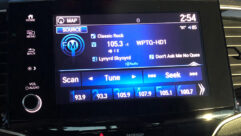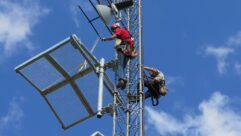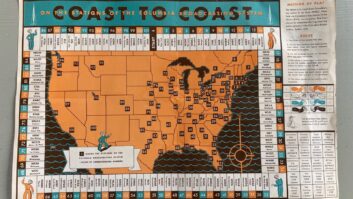(click thumbnail)
WBT’s transmitter building south of Charlotte, N.C., built in 1929, houses a government underground transmission facility constructed in 1963. The new PEP station facility can be seen behind and to the left.
At first glance, the old red-brick building built in 1929 with the big white letters “WBT” above the front door could be one of hundreds of rural radio transmitter sites in America. Yet what has not been visible to casual observers since 1963 has tied this particular site south of Charlotte, N.C., to the Cold War of an earlier era: a small underground transmissions facility resembling a fallout shelter — requested, built and paid for by Uncle Sam.
While the Cuban Missile Crisis of the early 1960s may now seem like ancient history, newer emergency scenarios of both the natural and manmade variety have surfaced in the early 21st century. Thus, the federal government once again sought to install emergency gear at the WBT(AM) transmitter site. The new setup is above ground, adjacent to the station’s old transmitter building.
WBT, a talker owned by Greater Media, covers much of the Carolinas during daytime hours; its 50,000-watt signal typically arcs directionally across most of the American eastern seaboard at night. It’s a Primary Entry Point station, one of a small group of broadcasters, mostly AMs, designated by the federal government to provide public information prior to, during and after a national or local emergency — which could mean catastrophes ranging from infrastructure-wreaking hurricanes and floods to crippling power outages and terrorism.
In June 2006, several months after Hurricane Katrina devastated the Gulf Coast, President Bush signed Executive Order 13407. It requires the United States to maintain an “effective, reliable, integrated, flexible and comprehensive system to alert and warn the American people,” according to the Federal Emergency Management Agency, part of the Department of Homeland Security.
That presidential order established the program within FEMA known as the Integrated Public Alert & Warning System, or IPAWS, whose partners include the FCC and National Weather Service.


Closeup of the older building’s exterior. “When it comes to emergency management and national preparedness, FEMA is not the team … FEMA is only part of the team,” spokesman Brad Carroll told Radio World. “That team includes federal partners, state, tribal and local officials, the private sector, non-profits and faith-based groups, and most importantly, the general public.” Carroll called it a prime example of an ideal public-private sector relationship.
Expanding the number of Primary Entry Point (PEP) stations is part of the IPAWS project.
“FEMA is in the process of expanding the number of private and commercial radio broadcast stations cooperatively participating with the agency to provide emergency alert and warning information to the public.”
The facilities buildout is expected to be completed in 2013; the number of PEP stations will increase by 38 stations — from 36 to 74, which FEMA estimates collectively can reach about 90 percent of the U.S. population.
The first station added to the PEP network was Cox outlet WOKV(AM), in Jacksonville, Fla., in 2010. “Legacy” PEP stations are getting the same standard equipment being installed in new stations as part of the effort.
‘New millennium’ version
The stated mission of IPAWS is to provide capabilities to local, state and federal authorities that enable them to alert their respective communities “via multiple communications methods.”
Among other things, the PEP network would provide the technological means to allow the president of the United States to speak from any location to the American people under all conceivable emergencies.
(Well, nearly all. The new PEP facilities are being built at ground level and likely cannot sustain a nuclear attack. But they apparently could withstand, for example, an electromagnetic pulse that could cripple parts of the nation’s power grid.)
Official sources confirm that the equipment complement for each station consists of a standardized package, but they decline to identify the specific components. However, RW confirmed that a typical PEP station is outfitted with a small modular shelter; a small generator; an EAS encoder/decoder compatible with Common Alert Protocol; satellite communications gear; and surge-protected backup program origination and transmission gear. When connected to the station transmitter, it essentially is a radio station unto itself for use by government officials in times of emergency.
WBT Chief Engineer Jerry Dowd said installation of the latest government facility at his transmission site was completed last fall.
He’s quick to add he hopes the new installation will wind up enjoying the same fate as the original 48-year-old underground facility on his site — thus also someday becoming a relic of a bygone era that will never have to be put into service. “This newer facility is the ‘new millennium version’ of the fallout shelter built back in ’63,” Dowd said with a smile.
(The original underground transmission facility remains intact. “Yes we have a can of 1963 crackers; the original water container, since emptied; the ‘toilet in a box’ thing; a couple of blankets; and the original guide to radiation monitoring handbook issued in 1963. We had the Geiger counters properly disposed of in years back, but we still have the old tube-type civil defense radio, and not much else has changed.”)
(click thumbnail)
Here’s a view of the original emergency transmission studios, built in 1963, soon after the Cuban Missile Crisis. The facility, underneath WBT’s 82-year-old-transmitter building, still has its original power source. WBT and the several dozen other broadcast outlets in the network remain an integral component of the far larger Emergency Alert System. All PEP stations are still tasked with providing first-generation broadcasts of any national EAS messages that would be forthcoming.
“We’re directional at night, up and down the East Coast, but [if necessary], we could be 50,000 watts non-directional if ever called upon,” said Dowd, whose transmitter site boasts a view that will bring tears to the eyes of some veteran engineers: a trio of now-rare Blaw-Knox Diamond towers.
The goal simply is to maximize the number of Americans who can receive one or more PEP signals. According to WBT’s Dowd, “When Katrina hit New Orleans and everyone saw that WWL(AM) could stay on the air, they realized it was the FEMA station and generator and equipment that people could rely on when it was most urgently needed by the most people.”
Selecting PEP outlets was fairly straightforward. Starting with the largest radio markets, each designated market area, or DMA, was examined by FEMA and IPAWS officials to determine if it was served by an existing PEP station. If not, the PEP program reviewed all local radio stations to determine which had the widest coverage. Key factors for PEP outlets typically included “superior technical facilities, station reach, cooperation of the station owner, transmitter site accessibility, environmental concerns and station stability.”
“I think when the day is done, this program is there to simply serve the public,” said Dowd. “Let’s hope we never need it, but isn’t it comforting to know that it’s there? This isn’t about ratings and the competition … it’s about all these [PEP] stations fulfilling a vital need to the American public, if ever necessary.”











